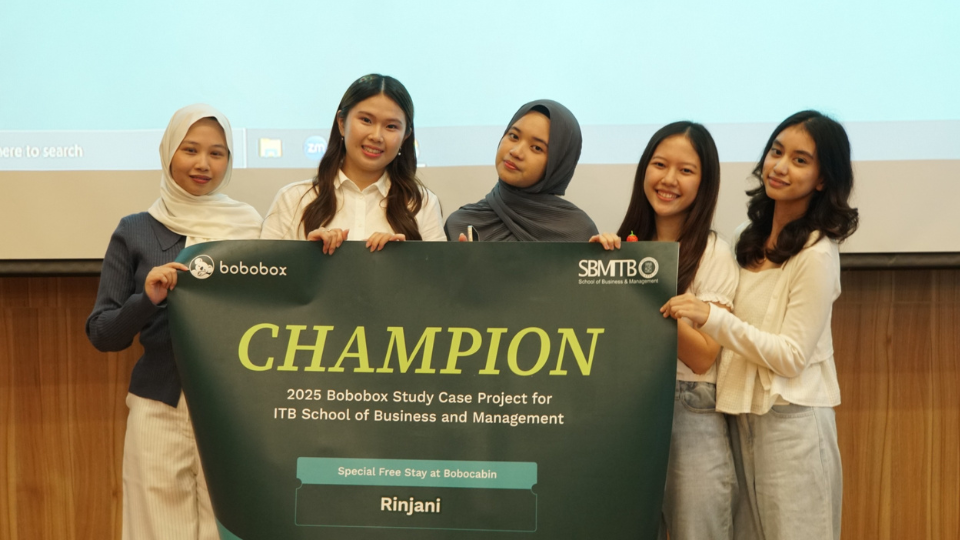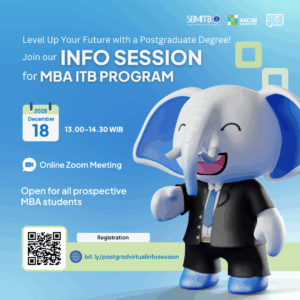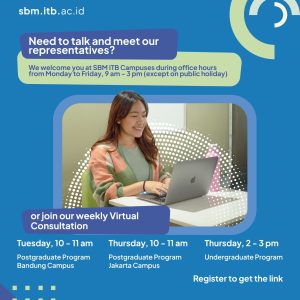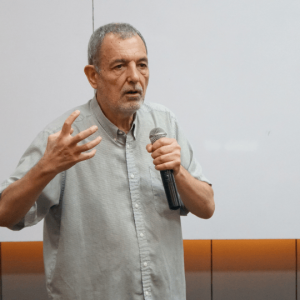An unusual twist marked the final exam for the Hospitality and Tourism Marketing course at the SBM ITB on Wednesday (11/6). Instead of a traditional written test, students were tasked with delivering a presentation on the marketing strategy of Bobocabin, a nature-based accommodation brand under Bobobox. The assignment challenged students to develop strategies aimed at boosting profitability and expanding international exposure to attract global tourists.
Students were divided into several teams, and each team was given a case study of a Bobocabin location spread across natural tourist destinations, such as Sumba, Kintamani, Rinjani, and Bunaken. These locations have extraordinary natural and cultural riches, but some of them have not been optimally exposed in the international tourism market. The challenge given to students was to design a marketing strategy that was not only creative but also relevant, effective, and oriented towards real impact.
In the presentation session, students began with an explanation of Bobocabin’s background, followed by an identification of the main problem and the focus of the project: the low number of foreign tourists staying at Bobocabin. The participating teams employed various research approaches, including field observations, literature reviews, and customer interviews, to gain in-depth insights into the topic.
One team proposed installing mobile advertisements in tourist areas, designing a variety of unique and engaging activity programs, and utilizing Virtual Reality (VR) technology to showcase the authentic atmosphere of Bobocabin.
However, the focus during the question-and-answer and evaluation session extended beyond innovative ideas. Particular attention was given to how thoroughly the proposed strategies were analyzed from a financial perspective. Students were expected to present cost estimates and project the return on investment (ROI) for their strategies, demonstrating a clear understanding of the financial implications.
Equally important was the emphasis on a customer-oriented approach. Students were encouraged to deeply consider customer needs, ensuring that their proposed solutions effectively addressed expectations and enhanced overall satisfaction.
Head of the SBM ITB Management Study Program, Achmad Fajar Hendarman, stated that the collaboration with Bobocabin aims to provide students with practical and contextual learning experiences. According to him, real cases like this provide an opportunity for students to understand industry challenges directly, while also training their analytical and problem-solving skills. Fajar hopes that this activity can be the first step for students to contribute to the development of the Indonesian tourism industry.
Bobobox Chief Commercial Officer (CCO), Bayu Ramadhan, expressed strong support for the initiative. As a token of appreciation, he awarded special prizes to the three best teams in the presentation: the opportunity to experience a stay at Bobocabin firsthand. Bayu emphasized that such direct experiences are essential for students to gain a customer’s perspective, ultimately enabling them to design more effective and relevant marketing strategies in the future.
The collaboration between Bobocabin and SBM ITB reflects both parties’ commitment to advancing programs that align with the Tri Dharma of higher education: education and teaching, research and development, and community service.
As a knowledge partner, Bobocabin is actively involved in a wide range of initiatives, including guest lectures, workshops, employer branding, industrial visits, and community-impact projects. This partnership also extends to developing lecture materials and curricula tailored to industry needs, offering internship opportunities, and supporting student recruitment.
In addition, the collaboration contributes to the achievement of international accreditations such as AACSB, with a strong emphasis on social impact and good governance. Future initiatives include the development of community engagement programs, the production of educational content via podcasts and social media, and potential cooperation in enhancing human resource competencies through both degree and non-degree programs.






